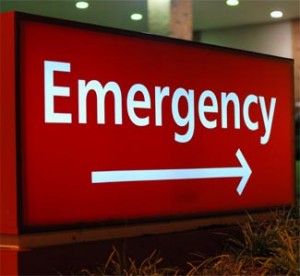Do I Need To Go To The ER?
 Twenty five years ago, doctors used to make house calls, but in the 21st century the only option you have is to stay home, see your doctor during office hours, use a walk-in clinic or go to the emergency. So how do you know if your symptoms are serious enough to warrant a trip to the local ER…. Here are some guidelines.
Twenty five years ago, doctors used to make house calls, but in the 21st century the only option you have is to stay home, see your doctor during office hours, use a walk-in clinic or go to the emergency. So how do you know if your symptoms are serious enough to warrant a trip to the local ER…. Here are some guidelines.
Heart attack symptoms:
These can include the “classic” symptoms of chest, left arm, or jaw pain, as well as shortness of breath, sudden dizziness, weakness, nausea; or unexplained sweating and fatigue.
Stroke symptoms:
A sudden numbness or weakness in a limb or one side of your face, sudden speech difficulties, trouble seeing out of one or both eyes, unexpected dizziness, loss of balance or an excruciating headache.
Trauma to the head:
If you receive a blow to the head that results in loss of consciousness, a seizure, or vomiting even if your symptoms happen a few hours after you hit your head.
Loss of consciousness/fainting:
It might be nothing more than you forget to eat, but it could also signal a heart problem or stroke.
Broken bone:
If your limb looks drastically misshapen or out of place, with swelling and bruising, and are not able to bear weight on the injured area.
Bleeding:
Bleeding that doesn’t stop when you apply pressure for 20 minutes or a gaping wound where you can see muscle, or bone.
Disorientation/confusion:
This could be a sign of stroke, seizure, dehydration, and other major problems.
Burns:
A burn that covers an area larger than 5 centimeters, breaks the outer layer of skin or causes numbness.
Bite/puncture wound:
Any bite where the skin is broken needs to be looked at; you may need antibiotics or a tetanus shot.
Ongoing pain:
Severe pain halfway down your back on either side of your spine, could signal a kidney stone or infection, as well as severe abdominal pain which can be appendicitis.
Unexplained fever:
An ongoing fever that can’t be controlled with acetaminophen or ibuprofen, or if your fever is 105 degrees or higher.
Abscess/infection:
Any abscess that is greater than the size of a quarter with an area around it that’s red and swollen.
Remember that these are only guidelines, and if you are unsure, err on the side of caution and call your health care practitioner, or go to the emergency.


Leave a Reply
Want to join the discussion?Feel free to contribute!